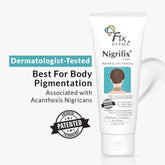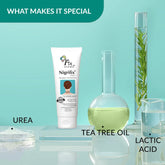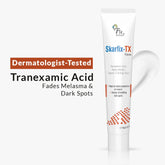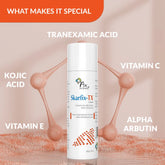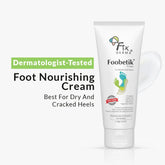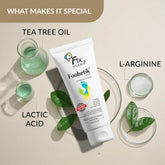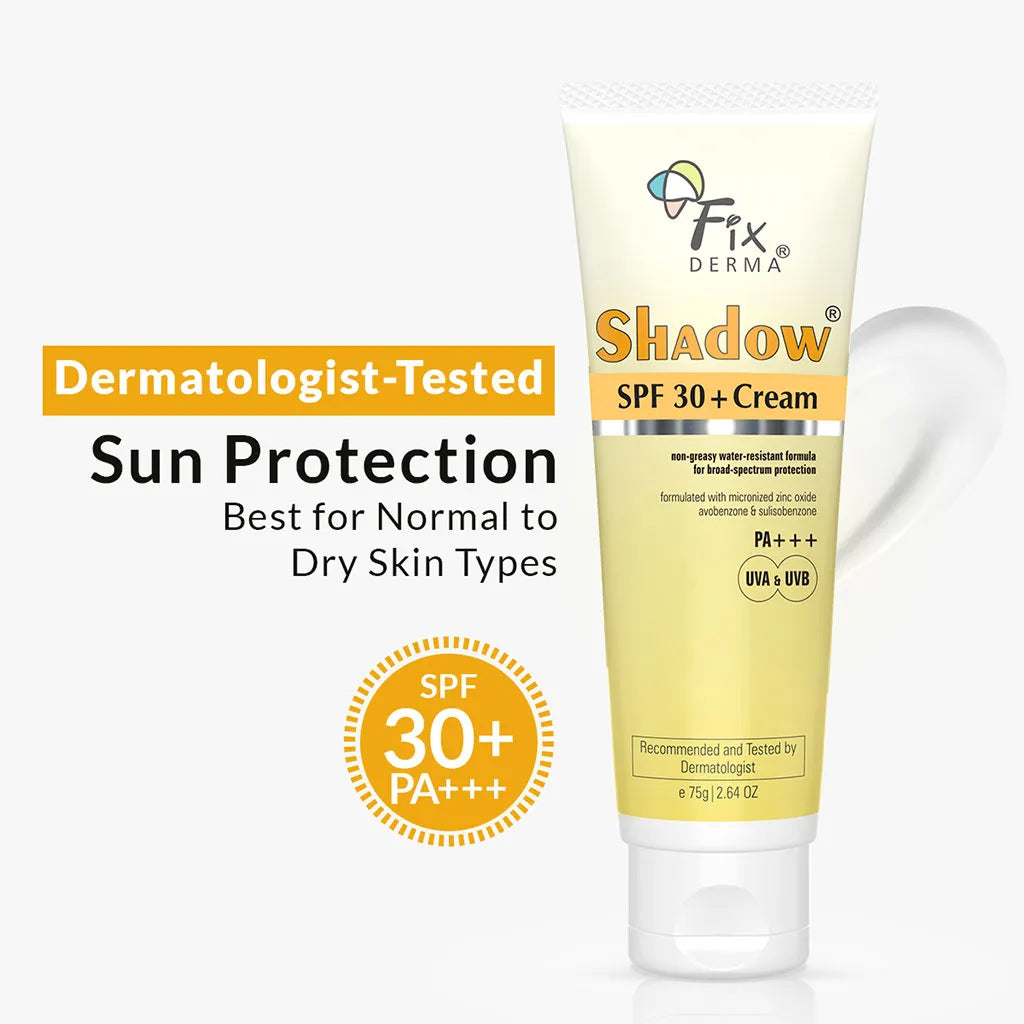







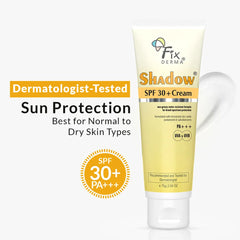
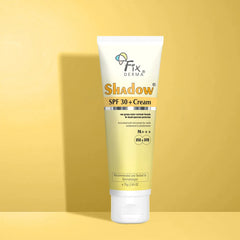

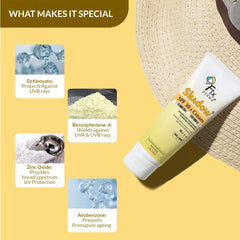




Manufactured By : Fixderma India Private Limited
Address: F-169-170, EPIP Zone, Neemrana, Distt Alwar, Rajasthan - 301705, INDIA
Precautions: Do a patch test before first use. Discontinue or consult your dermatologist if irritation occurs.
KEY HIGHLIGHTS
 Broad spectrum protection
Broad spectrum protection  Water-Resistant
Water-Resistant  PA+++
PA+++  Non-Comedogenic
Non-Comedogenic  No white cast
No white cast
- What is it?
- Backed by Science
- Directions for Use
- Ingredients
Shadow SPF 30+ Cream is a lightweight, broad-spectrum cream-based sunscreen that provides protection against both UVA rays & UVB rays. Its quick-absorbing formula makes it a part of your skin without leaving a white cast. This non-greasy sunscreen is ideal for all weather and skin types.
It is an ideal sunscreen with physical blockers and chemical absorbers that protect skin from UVA and UVB rays. This cream-based sunscreen does not cause white cast is ideal for dry skin but works effectively for all skin types.
-
 Take out the required amount of sunscreen on your fingertips.
Take out the required amount of sunscreen on your fingertips. -
 Gently massage it all over your face, neck and areas exposed to the sun.
Gently massage it all over your face, neck and areas exposed to the sun. -
 Reapply as necessary.
Reapply as necessary.
-

OCTINOXATE
The oldest and most common sunscreen actively used to protect skin, primarily against UVB rays. It absorbs UVB radiation peak protection and has a solid record of safety (decades of research and thousands of studies establishing its safety in sunscreens as indisputable). -

BENZOPHENONE-4
It absorbs properties that filter and block out harmful UV rays. It is quite effective in not only filtering out UV rays but also preventing other ingredients from being degraded by the sun. -

ZINC OXIDE
Scatters the sun's rays, which prevents potentially damaging ultraviolet radiation from getting to the skin. The finely powdered mineral formula used in sunscreen does two things—reflect and absorb. It absorbs harmful UVA and UVB rays so that they do not reach your skin. -

AVOBENZONE
It is an organic material that helps reduce the amount of UV light to which the human skin is exposed by absorbing and refracting the radiation and subsequent disposal.
Your Everyday Shield: Broad-Spectrum Protection for All Skin Types
Sunscreen is a very important part of our daily skincare routine, protecting us from the harsh UV rays. Prolonged exposure to UV radiation can cause premature aging, skin damage and even skin cancer. Using a broad-spectrum sunscreen with SPF can help prevent these issues. Sunscreens work by absorbing and reflecting UV rays, preventing them from penetrating the skin. UVA rays cause premature aging, while UVB rays. cause sunburn. Look for sunscreens labelled “broad spectrum” as they protect against both UVA and UVB rays. Fixderma Shadow SPF 30+ cream is a non-greasy sunscreen cream, ideal for all weather and skin types. This cream protects your skin from the harmful sun rays and gives your skin the best protection. You just cannot skip putting on sunscreen, because it is one of the most important products that you cannot miss adding in your skincare routine. Always go for a sunscreen that gives PA +++ protection to your skin and has SPF 50. Fixderma Shadow SPF 30+ cream has all of this and that’s what gives you the best sun protection.
Non-comedogenic & Safe for Every Skin Type
Fixderma Shadow SPF 30+ cream is a non-comedogenic sunscreen cream. This means that it doesn’t clog pores. This sunscreen gives broad-spectrum protection to your face and is water-resistant as well. It is one of the best sunscreens if you want something lightweight and non-greasy without any white cast. There are many sunscreens in the market but this one actually protects your skin so well that the sun cannot even touch your skin.
This sunscreen can be your all-time companion, not just in summers but in all seasons. You should not skip using sunscreen and should use it every day. Your skin deserves the right care and protection and only you can give it to your skin by using the right products.
All Day Defense, Zero White Caste
When choosing a sunscreen, consider your skin type, SPF level and whether it has PA+++ or not. A sunscreen that has the right benefits can only be your go to partner every day. Because sunscreen is something that you cannot miss and that’s why you need to make sure that it has the right SPF and also if it is suitable to your skin or not. A sunscreen not only provides UV protection but also protects your skin from the blue light. So, wearing it every time is safe and will only help you with protecting your skin. This sunscreen of Fixderma is dermatologist tested and recommended and that’s why it is one of the most trusted sunscreens and is loved by so many. If you are confused as to which sunscreen to choose, then with no doubt, you can go for the Shadow Sunscreen SPF 30+ Cream.
Your daily dose of sun-smart skin care
Not just for beach days or sunny days, your sunscreen needs to be your daily must-have, no matter the weather. Fixderma Shadow SPF 30+ cream protect from the harsh UV rays. It prevents premature aging of skin and keeps skin hydrated and glowing. You can use this sunscreen daily and reapply every 2 hours or after swimming and sweating. Make sunscreen your daily habit and thank yourself later.
What is SPF 30 Sunscreen?
SPF 30 sunscreen refers to a specific type of sunblock or sunscreen product used to protect the skin from the harmful effects of ultraviolet (UV) radiation from the sun. SPF stands for "Sun Protection Factor," and it is a measure of how effectively a sunscreen can shield your skin from UVB (ultraviolet B) rays, which are the type of UV radiation responsible for causing sunburn, skin damage, and an increased risk of skin cancer.
What does SPF 30 Sunscreen protect your skin against?
Here's how SPF 30 sunscreen works:
- SPF Rating: The SPF rating indicates the level of protection a sunscreen provides. SPF 30 means that when properly applied, the sunscreen can block approximately 97% of UVB rays. In other words, it allows only about 1/30th (3.33%) of UVB radiation to reach the skin.
- Duration of Protection: SPF 30 sunscreen provides protection for a certain period of time, depending on various factors such as the individual's skin type, sweating, swimming, and the amount of sunscreen applied. It is generally recommended to reapply sunscreen every two hours or more frequently if you are swimming or sweating heavily.
- Broad-Spectrum Protection: Effective sunscreens provide broad-spectrum protection, which means they protect against both UVB and UVA (ultraviolet A) rays. UVB rays primarily cause sunburn, while UVA rays contribute to skin aging and can also lead to skin cancer. SPF 30 sunscreen are typically designed to provide broad-spectrum protection.
- Sunscreen Application: To achieve the SPF level stated on the product, you must apply an adequate amount of sunscreen evenly to all exposed skin areas. Many people don't apply enough sunscreen, which can reduce the actual SPF protection achieved. You can check out our Shadow Sunscreen SPF 30+ Cream.
When can you apply SPF 30 sunscreen?
You can apply SPF 30 sunscreen whenever you anticipate exposure to the sun. Here are some common situations and guidelines for applying SPF 30 sunscreen:
- Daily Use: It's a good idea to incorporate SPF 30 sunscreen into your daily skincare routine, even on cloudy or overcast days. UV radiation can penetrate cloud cover, and cumulative sun exposure over time can lead to skin damage and premature aging. Apply it in the morning after your moisturizer but before your makeup if you wear any.
- Outdoor Activities: Whenever you plan to spend time outdoors, especially during peak sun hours (usually between 10 a.m. and 4 p.m.), apply SPF 30 sunscreen generously to all exposed skin. Reapply it every two hours or more frequently if you are sweating heavily or swimming.
- Beach and Pool Days: When going to the beach or pool, apply SPF 30 sunscreen before heading out and reapply it after swimming or toweling off. Waterproof or water-resistant sunscreen is a good choice for water-related activities.
- Sports and Exercise: If you're engaging in outdoor sports or physical activities, apply SPF 30 sunscreen to areas of your skin that will be exposed to the sun. Sweating can reduce sunscreen effectiveness, so reapply as needed.
- Travel: Whether you're on a vacation or a business trip, if you plan to spend time outdoors, use SPF 30 sunscreen to protect your skin. Remember to reapply regularly, especially if you're in a sunny destination.
- Special Occasions: If you have an outdoor event, such as a wedding, picnic, or festival, where you'll be exposed to the sun for an extended period, apply sunscreen before heading to the event. Consider using makeup or skincare products that contain SPF as well.
- Hiking and Camping: When hiking or camping, be diligent about sunscreen application, as you'll likely be exposed to the sun for an extended period. Apply before starting your outdoor adventure and carry sunscreen with you for reapplication.
Additionally, even on days with milder sun exposure, it's a good habit to protect your skin. UV radiation can have cumulative effects over time, so consistent sunscreen use can help maintain healthy skin and reduce the risk of sunburn and skin damage.
What to look for in a sunscreen for dry skin?
When looking for sunscreen for dry skin, you'll want to find a product that not only provides effective sun protection but also offers hydration and addresses the specific needs of dry skin. Here are some key factors to consider when choosing a hybrid sunscreen for dry skin:
- Broad-Spectrum Protection: Ensure that the sunscreen offers broad-spectrum protection, which means it protects against both UVA and UVB rays. UVB rays cause sunburn, while UVA rays can lead to premature skin aging and contribute to skin cancer. Look for sunscreen with SPF 30 or higher for adequate sun protection.
- Hydration: Dry skin needs extra moisture, so opt for a hybrid sunscreen that contains hydrating ingredients which can help lock in moisture and keep your skin hydrated throughout the day.
- Non-Comedogenic: If you have dry skin, it's still important to choose a sunscreen that won't clog your pores. Look for products labeled as "non-comedogenic" to reduce the risk of breakouts.
- Texture: Consider the texture and consistency of the sunscreen. Creamy or lotion-like sunscreens are often better suited for dry skin compared to gel-based or matte formulations, which can be drying.
- Fragrance-Free: Fragrances can sometimes irritate dry or sensitive skin. To avoid potential irritation, choose a fragrance-free or hypoallergenic sunscreen.
- Ingredients: Check the ingredient list for any potential irritants or allergens. Some people with dry skin may be sensitive to certain ingredients. Avoid products with ingredients that have caused reactions in the past.
- Added Benefits: Some sunscreens may offer additional benefits, such as antioxidants or anti-aging ingredients. These can be beneficial for maintaining healthy skin and combating the effects of sun exposure.
- Water-Resistant: If you anticipate sweating or swimming, consider a water-resistant hybrid sunscreen. Keep in mind that even water-resistant sunscreens should be reapplied after swimming or heavy sweating.
- Dermatologist-Recommended: If you have specific concerns about your skin or are unsure which product is best for your skin type, consider consulting with a dermatologist. They can recommend a sunscreen that suits your individual needs.
Remember that individual preferences and skin sensitivities can vary, so it may take some trial and error to find the perfect hybrid sunscreen for your dry skin. Be diligent about applying sunscreen daily, especially on exposed skin areas, to protect your skin from the harmful effects of the sun and to keep it hydrated and healthy.
Tips for using sunscreen when you have dry skin.
Using sunscreen when you have dry skin is essential for protecting your skin from the sun's harmful UV rays while maintaining skin hydration. Here are some tips for effectively using sunscreen on dry skin:
- Choose the Right Sunscreen: Opt for a sunscreen designed for dry or sensitive skin. Look for labels like "hydrating," "moisturizing," or "for dry skin”. Select a broad-spectrum sunscreen with SPF 30 or higher for adequate sun protection.
- Moisturize First: Apply a moisturizer designed for dry skin before applying sunscreen. This helps create a barrier between your skin and the sunscreen, preventing it from drying out your skin.
- Apply Sunscreen Generously: Use enough sunscreen to cover all exposed skin areas, including your face, neck, ears, arms, and legs. Pay extra attention to areas prone to sunburn, like the nose, cheeks, and shoulders.
- Reapply Regularly: Reapply sunscreen every two hours or more frequently if you are swimming or sweating. Applying a moisturizing sunscreen can help maintain skin hydration throughout the day.
- Use Sunscreen Daily: Make sunscreen a part of your daily skincare routine, even on cloudy or overcast days. UV rays can penetrate cloud cover. Apply sunscreen in the morning after moisturizer but before makeup, if you wear any.
- Look for Hydrating Ingredients: Choose sunscreens with contain hydrating ingredients that help lock in moisture and prevent dryness. Some sunscreens are formulated with added moisturizing benefits for dry skin.
- Avoid Harsh Ingredients: Check the ingredient list for alcohol-based or astringent ingredients that can be drying. Opt for products that are alcohol-free or specifically formulated for sensitive skin.
- Fragrance-Free Options: If you have sensitive or dry skin, choose fragrance-free or hypoallergenic sunscreens to reduce the risk of irritation.
- Patch Test: If you're trying a new sunscreen, it's a good idea to do a patch test on a small area of your skin to ensure you don't have an adverse reaction.
- Seek Shade and Wear Protective Clothing: In addition to sunscreen, seek shade during peak sun hours (10 a.m. to 4 p.m.) and wear protective clothing, such as wide-brimmed hats, sunglasses, and long-sleeved clothing, to reduce sun exposure.
Remember that consistent use of sunscreen is crucial for protecting your skin from sun damage, reducing the risk of skin cancer, and preventing premature aging. By selecting the right sunscreen and following these tips, you can help keep your dry skin protected and moisturized.
Frequently Asked Questions
-
Can I use Fixderma Shadow SPF 30+ Cream every day?
Absolutely! This sunscreen is designed for everyday use and is suitable for all seasons. Whether you’re indoors or outdoors, you can apply it daily.
-
Is this sunscreen suitable for all skin types?
Yes, this sunscreen cream has a non-greasy, non-comedogenic formula that suits every skin type — including oily, dry, and sensitive skin.
-
Does it protect from both UVA and UVB rays?
Yes, it offers broad-spectrum protection against both UVA rays and UVB rays.
-
Will it leave a white cast on my skin?
No. The Fixderma Shadow SPF 30+ cream is formulated to blend seamlessly into the skin, leaving no white cast or greasy residue.
-
Can I wear makeup over this sunscreen?
Definitely! Its lightweight, non-sticky texture makes it a perfect base for makeup.
-
How often should I reapply this sunscreen?
Reapply every 2-3 hours if you’re outdoors, and after swimming, sweating, or towel-drying.
-
What makes this sunscreen different from others?
Unlike many heavy sunscreens, Fixderma Shadow SPF 30+ cream is lightweight, non-comedogenic, and dermatologist-tested. It protects effectively without clogging pores or making the skin feel sticky.
-
Is sunscreen SPF 30 sufficient for sun protection?
Yes, our Fixderma sunscreen SPF 30 provides a high level of protection for most daily activities. For extended outdoor exposure, you may need to reapply frequently and consider our higher SPF options.
-
Is Fixderma Shadow sunscreen SPF 30 suitable for dry skin?
Yes, our Fixderma shadow sunscreen SPF 30 is specially formulated to be hydrating and nourishing, making it ideal for dry skin. It helps to moisturize while providing sun protection.
-
Is sunscreen SPF 30 safe for sensitive skin?
Yes, our Fixderma shadow sunscreen SPF 30 is dermatologist-tested and suitable for sensitive skin. However, we recommend doing a patch test before extensive use if you have specific skin concerns.
-
Does sunscreen SPF 30 contain any harmful chemicals?
No, our sunscreen SPF 30 is free from parabens, sulfates, and other harmful chemicals. We prioritize safe and effective ingredients to protect your skin.
-
What does broad-spectrum mean in sunscreen SPF 30?
Broad-spectrum means that the sunscreen provides protection against both UVA and UVB rays. This comprehensive protection helps prevent sunburn, premature aging, and skin cancer.
-
Will sunscreen SPF 30 leave a white cast on my skin?
No, our fixderma shadow sunscreen SPF 30 is formulated to blend seamlessly into the skin without leaving a white cast. It’s suitable for all skin tones.
- Choosing a selection results in a full page refresh.
